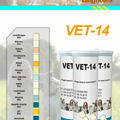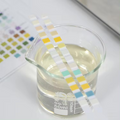Urine Test Strips x 50 for Dogs & Cats, 14 Disease Parameters
Carefully Crafted Products
At DogsFirst, we understand your dog's health means everything. Each product is carefully crafted with your dog's wellbeing in mind, guided by Dr. Brady’s extensive veterinary expertise.
Vet-Backed Science
Every formula is developed by Dr. Conor Brady, ensuring all ingredients are research-backed and vet-approved for maximum health benefits.
Natural & Safe Ingredients
We use only natural, premium-quality ingredients—no artificial additives, fillers, or preservatives. Just pure goodness your dog deserves.

Visible Health Improvements
Our customers regularly report noticeable benefits, including improved digestion, shinier coats, increased energy, and overall vitality.
Education & Support
Gain more than just products; access detailed educational resources designed to empower you in making informed choices for your pet's health.
FAQs
We ship worldwide, quickly and affordably. Whether you’re in Ireland or Indonesia, we aim to
dispatch all orders within 24 hours on business days (we don’t ship Bank Holidays!).
- Shipping costs are kept as low as possible, and you'll see exactly how much it will cost at
checkout, before you confirm your order. - Delivery times vary by region, Irish orders take 24hrs; UK 48hrs; EU 2-3 days; US/Canada 3-5 days; Rest of World 5 days
We’re committed to providing exceptional products and support. If you have any concerns, don’t hesitate to reach out—we’re here to help.
Should things not go well, we accept returns within 30 days of purchase.
Please mark your parcel “Dogs First Ltd RETURNS” and ship your package to Unit B3,
Carrowmoneash, Deerpark Industrial Estate, Co. Galway, H91 D452
To be eligible for a return:
- You must first confirm with us (info@dogsfirst.ie / social media) that a return is on the way.
- The item must be unopened, unused, and undamaged.
- A receipt or proof of purchase from our store is required.
Please note: Due to the nature of pet supplements, we cannot accept returns on opened products unless there is a defect or damage.
If your item arrives damaged or you believe it’s defective:
1. Contact us at info@dogsfirst.ie within 7 days of receiving your order.
2. Please include a photo of the product and a brief description of the issue.
3. We’ll assess the claim and, if approved, will offer a replacement or full refund, including shipping.
Once your return is received and inspected, we’ll notify you of the approval or rejection of your refund.
- If approved, your refund will be processed and applied to your original method of payment within 5–10 business days.
- Shipping costs are non-refundable, unless the return is due to our error.
We do not offer direct exchanges. If you'd like a different product, please return your item (if eligible) and place a new order.












